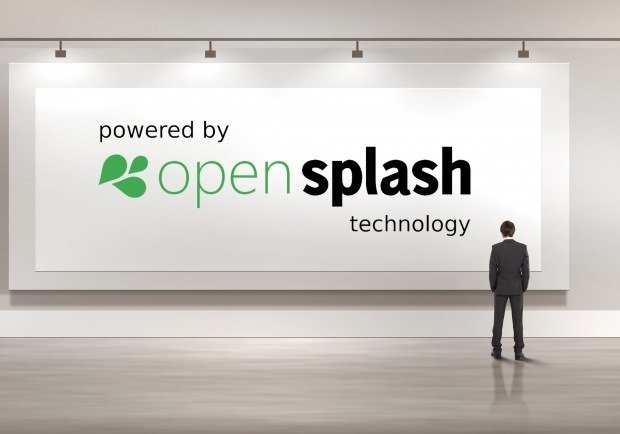
OpenSplash’s only requirement is that its logo be displayed clearly for three seconds at start-up (image © Sergej Khackimullin / Fotolia, adapted)
It’s been over a year since Ayuda’s open-source digital signage player, OpenSplash, was donated to the industry. OpenSplash is a free, multi-platform media player designed to be driven by any network-based content management system (CMS). A few companies, including ComQi, Onelan, X20 Media and signagelive, have taken up the opportunity that this player offers. But the question is, why aren’t more businesses adopting it?
Andrew Neale is a digital signage expert who has been involved with OpenSplash from the very beginning, and Marc Benson, chief technology officer at cloud-based digital signage software provider signagelive, are both members of the OpenSplash steering committee.
“At signagelive we see OpenSplash as an opportunity for vendors, system integrators and most importantly innovative minds to create differentiating and engaging solutions using a solid foundation,” Benson explains. “OpenSplash contains all the core functionality expected of a media player whilst enabling developers to customise and extend virtually any part of the application.
“Although that sounds a bit like ‘techie marketing’, having a high-quality core solution enables new ideas to be delivered quickly and with confidence, knowing that your application is built on a solid foundation that can be connected to any CMS provider. This must be a compelling proposition for anyone looking to build a solution.” The idea with OpenSplash is that companies will be able to use their content management system and build a quality media player without having to reinvent the wheel. Having a common player platform could also promote standards for within the digital signage industry, which would be highly beneficial, with the added benfit of making it easier for legacy networks to migrate into new, more sophisticated networks.
Neale points out: “One obvious benefit that has emerged when talking to vendors and network operators is that there is a need for standardisation. This is especially apparent when mergers and acquisitions mean that operators end up with running a number of platforms to manage their assets. This is inefficient and unnecessarily difficult to manage successfully.
“Because of the modular structure of OpenSplash, any migration process from one CMS to another would be much easier as there would only need to be an update to an existing OpenSplash player, rather than having to replace the player completely. We heard of a case where the operator had to deal with over ten legacy platforms in one portfolio.”
Interoperability and standardisation are two factors that have brought other industries forward, enabling better collaboration between businesses and reducing development costs.
“OpenSplash is not the first attempt at standardisation within our industry, and I doubt it will be the last,” says Benson. “However, I don’t believe we have yet seen the out-of-home industry fully embrace OpenSplash. I think this can probably be attributed to most vendors having a fear of losing control of the end point, but this fear is unfounded.
“Conversely, many screen manufactures bundle poor-quality software solutions to enable them to sell their panels as the software is free. By bundling OpenSplash, the consumer has choice of CMS to fit their needs – whether they opt for a commercial platform, such as signagelive, or a free platform.”
signagelive has invested heavily into ensuring that as much functionality as possible is available to any unit connecting to its platform, no matter how simple the end device may be. Benson continues: “Later this year we will be releasing our Player API that will enable any media player to connect to the signagelive platform. As part of this initiative we will add an open-source connector for OpenSplash and signagelive, which we hope will drive further innovation.”
Neale concludes: “Because the software is open source and freely available to anyone to use, we don’t know how many or who exactly is using the software out in the field, but we hope that people will give us feedback that we can announce publicly. There have been a number of interesting discussions that we have heard about, and we hope to be able talk about them soon.”
Benson’s parting tip: using Mono ensures that any solutions developed on OpenSplash have the potential to be delivered across multiple platforms, including Windows, Linux, Android and iOS.